Charlotte favors transit, even though few use it
Polls show mixed perceptions of CATS
You’re reading Transit Time, a weekly newsletter for Charlotte people who leave the house. Cars, buses, light rail, bikes, scooters … if you use it to get around the city, we write about it. Transit Time is produced in partnership between The Charlotte Ledger and WFAE.
Internal polls and surveys conducted by CATS show strong majorities have favorable impressions of transit — but that there’s room for improvement, too
by Tony Mecia
Most Mecklenburg County residents believe that Charlotte’s bus system and light rail line help reduce pollution and serve the vital role of transporting people to their jobs.
Yet most of those same residents never use public transportation.
Those are a couple of the results from the most recent community poll commissioned by the Charlotte Area Transit System. For years, CATS has used an outside research firm to conduct surveys of residents, riders and employees. It typically does not share them publicly. Transit Time learned of their existence this spring and recently received a batch of reports dating to 2019 after requesting them under public records laws.
Perceptions of CATS are expected to be an important factor in the $25 billion regional transit plan that took shape this summer. That plan calls for building additional rail lines, improving bus service and putting money into street projects, paid for mostly through raising Mecklenburg’s sales tax. Voters would have to approve the plan, which is still awaiting action by the General Assembly.
Even after CATS’ recent high-profile missteps and a management shake-up, the surveys show that the public and transit riders largely have favorable impressions of Charlotte buses and light rail.
But there are some negatives, too. The public generally gives CATS low marks for the perception of safety on buses and at transit stops. And CATS riders say they have less positive impressions of public transit than riders in other cities, while also saying they want more frequent service and more shelters at bus stops.
Here are a few of the highlights:
Public perception: public transit is needed — but few use it
◼️ Important to the community: By large margins, poll respondents say they think public transit is vital:
85% say CATS is a “valuable part of the community”
79% say CATS “contributes to the success of the community”
73% say it provides access to places of employment
79% say it provides affordable transportation options
76% say it provides mobility to low-income families
66% say it reduces pollution
61% say it reduces traffic congestion
The poll shows that the public believes CATS serves an important purpose.
◼️ Few riders: However, most of the people polled don’t ride buses or light rail. CATS’ ridership is down about 44% since peaking in 2014. According to the survey:
44% said they had never ridden CATS
7% said they used to ride it but don’t anymore
34% said they ride it once a month or less
31% said that CATS was valuable to them personally
The majority of those polled (51%) said they don’t ride CATS, and just 15% said they ride it more than twice a month.
◼️ Safety perceptions: In addition, people answering the poll question indicated that they had concerns about safety:
37% agreed with the statement: “CATS buses and trains are safe from crime”
29% agreed with the statement: “CATS stops and stations are safe from crime”
35% agreed with the statement that “CATS improves property values”
◼️ Transit plan favored: The poll also asked residents about their perception of Charlotte’s emerging transit plan. About 75% said they had a “positive” or “very positive” impression of it. That’s generally in line with other polls suggesting local residents favor more funding for transit, although the poll questions typically don’t ask about specific funding sources, like higher taxes, which could dampen enthusiasm in poll results.
The poll was conduced in May 2023 of 391 Mecklenburg residents. It has a margin of error of plus or minus 4.96 percentage points.
➡️ See the survey of Mecklenburg residents here.
Rider perceptions: Buses
Highlights of a November 2023 survey of CATS riders.
◼️ Satisfied but below average: A majority of bus riders said they liked the service provided:
66% of bus riders said they were satisfied with CATS’ service — though that is below the industry average of 80%
◼️ Seeking better service: Majorities of bus riders said they would like more buses and more amenities at stops:
64% said they would like more frequent service
52% said they would like better timed transfers between services
51% said they would like more shelters at bus stops
39% said they would like more benches at bus stops
The overall satisfaction of CATS bus riders has slipped since 2019 and is below industry averages.
◼️ Essential: Majorities of bus riders said they rely on CATS for essential purposes:
57% of bus riders said they use buses to get to work, with another 8% saying they use it for medical appointments
93% described themselves as “transit-dependent”
58% said they did not have a driver’s license
◼️ Demographics of bus riders:
35% were aged 34 or under
62% were male
75% were Black, 11% were white, 5% were Hispanic
At least 48% had incomes of less than $50,000 a year (47% did not disclose their income)
Rider perceptions: Light rail
◼️ Satisfied and at average levels: A majority of light rail riders said they liked the service provided:
77% of light rail riders said they were satisfied with CATS’ service — right at the industry average (77%)
◼️ Seeking better service: Majorities of rail riders said they would like more trains:
74% said they would like more frequent service
59% said they would like better timed transfers between services
A survey of CATS light rail riders shows high but declining levels of satisfaction in on-time performance, fare price and customer service.
◼️ Demographics of rail riders:
58% said they have a driver’s license
59% said they were age 34 or under
61% were male
57% were Black, 25% were white, 12% were Hispanic
At least 43% had incomes of less than $50,000 a year (33% did not disclose their incomes)
The in-person survey was conducted in November 2023 of 1,129 bus riders and 548 rail riders who were riding or waiting for transit.
➡️ See the survey of bus and rail passengers here.
The surveys were conducted by a research firm specializing in transit agencies called TransPro. Transit Time requested them in May under North Carolina’s public records laws and received them in October.
The Charlotte City Council in May approved a contract with Hickory-based Jackson Insight for annual CATS survey research, which will be “used to identify concerns and areas where transit services need to be improved and/or better communicated.” The expected annual cost is estimated at $232,000.
Tony Mecia is executive editor of The Charlotte Ledger. Reach him at tony@cltledger.com.
Transit Time is a production of The Charlotte Ledger and WFAE. You can adjust your newsletter preferences on the ‘My Account’ page.
Did somebody forward you this newsletter and you need to sign up? You can do that here:
Other affiliated Charlotte newsletters and podcasts that might interest you:
The Charlotte Ledger Business Newsletter, Ways of Life newsletter (obituaries) and Fútbol Friday (Charlotte FC), available from The Charlotte Ledger.
The Inside Politics newsletter, available from WFAE.





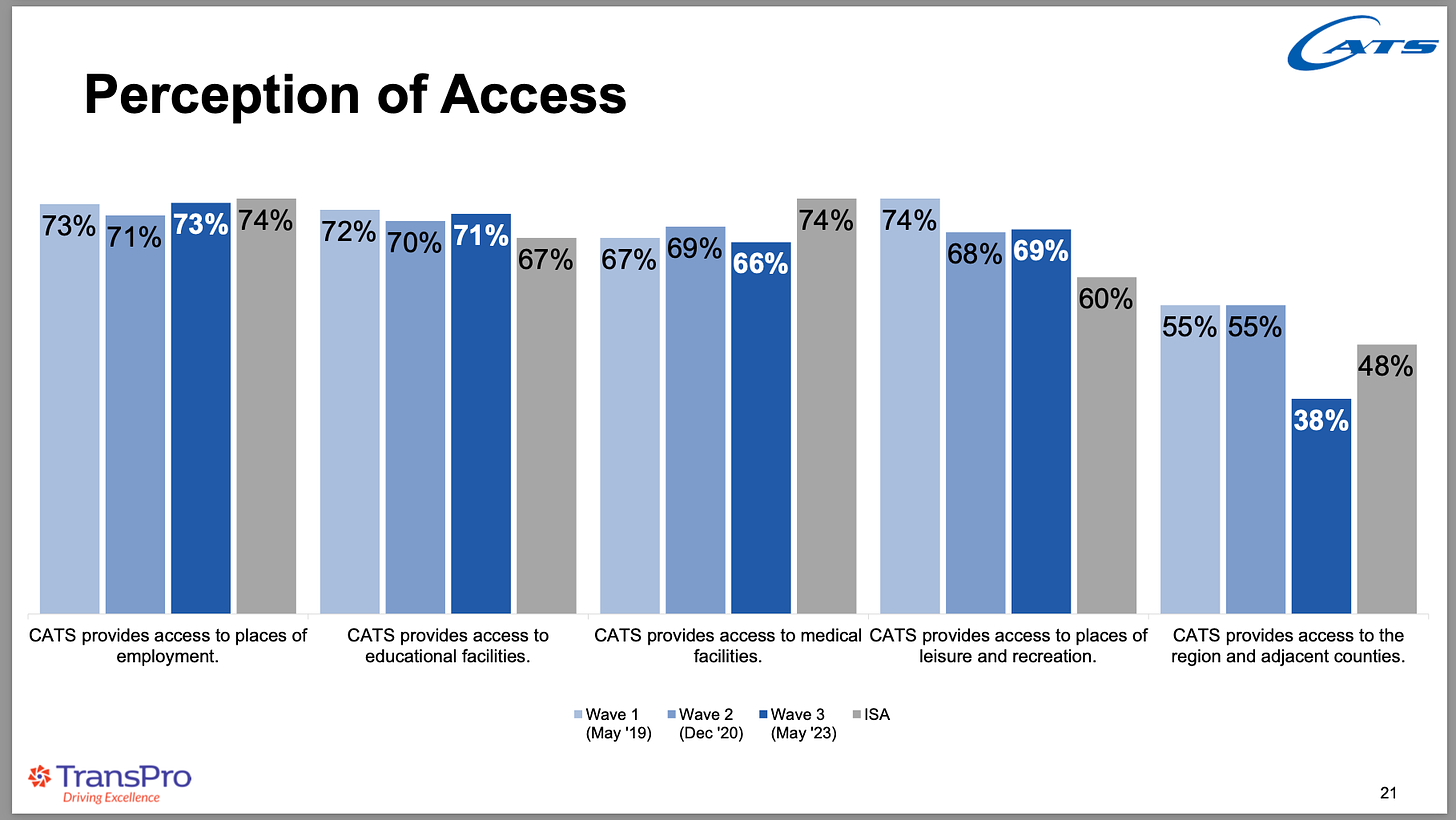
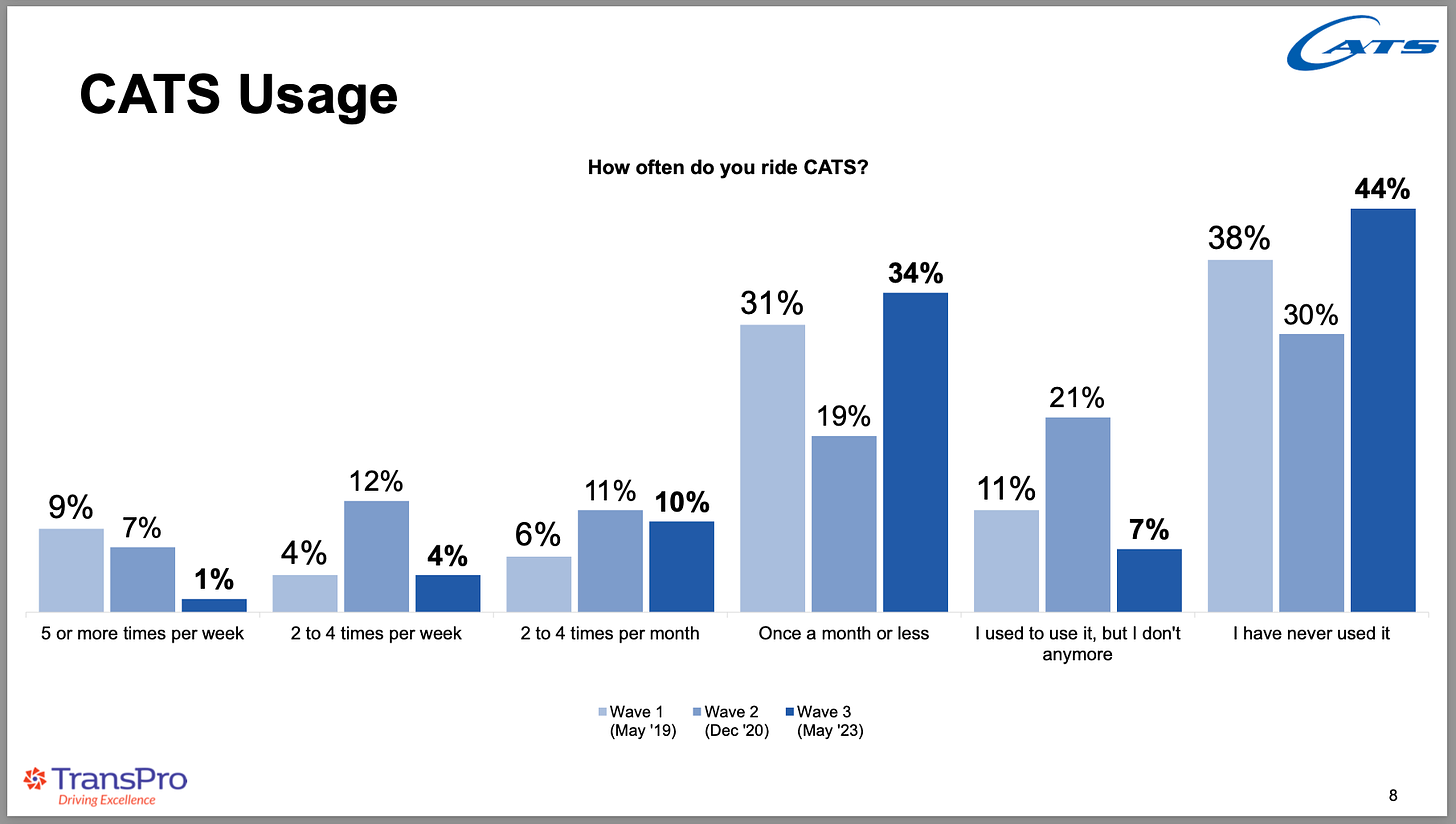
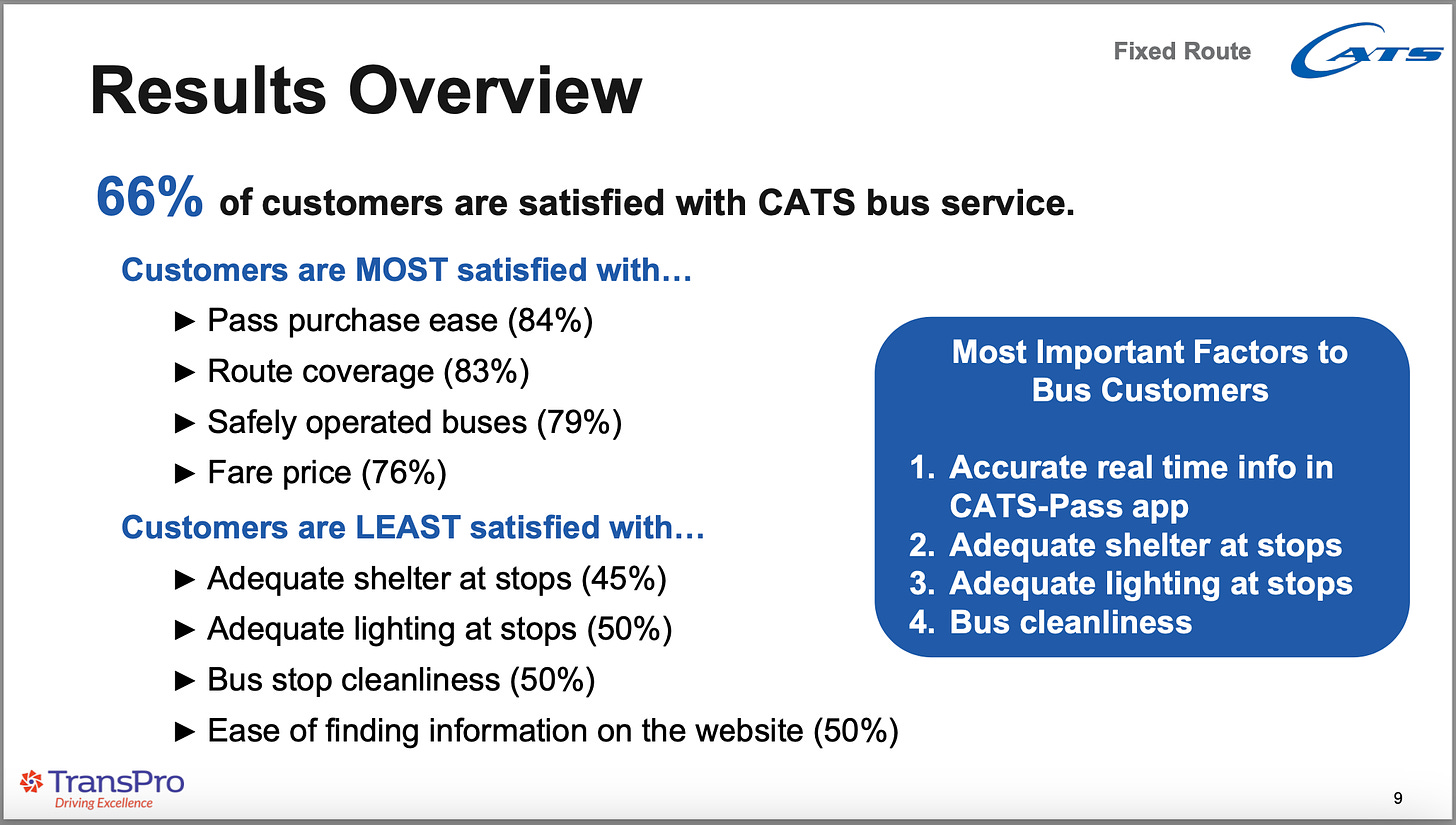
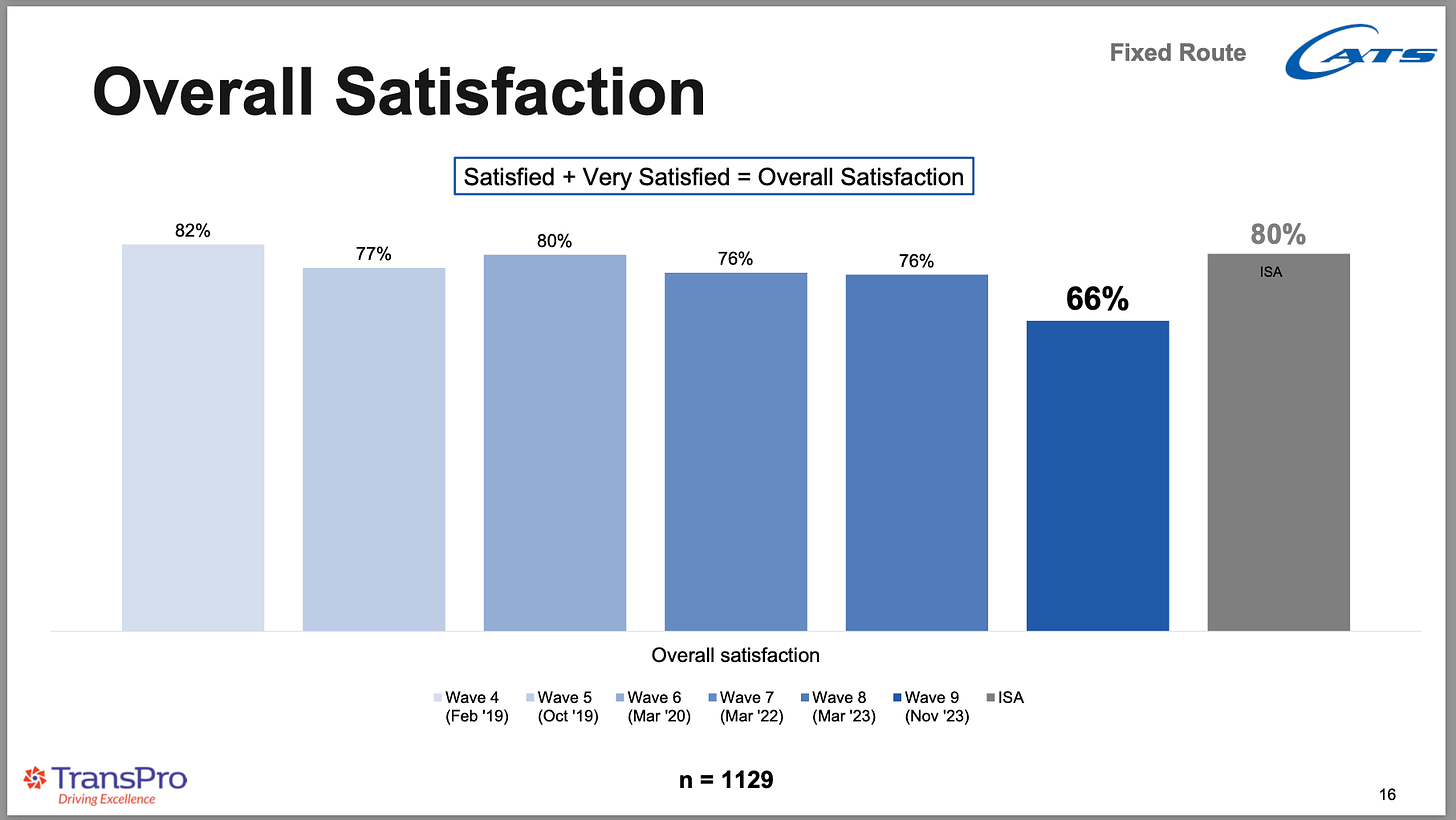
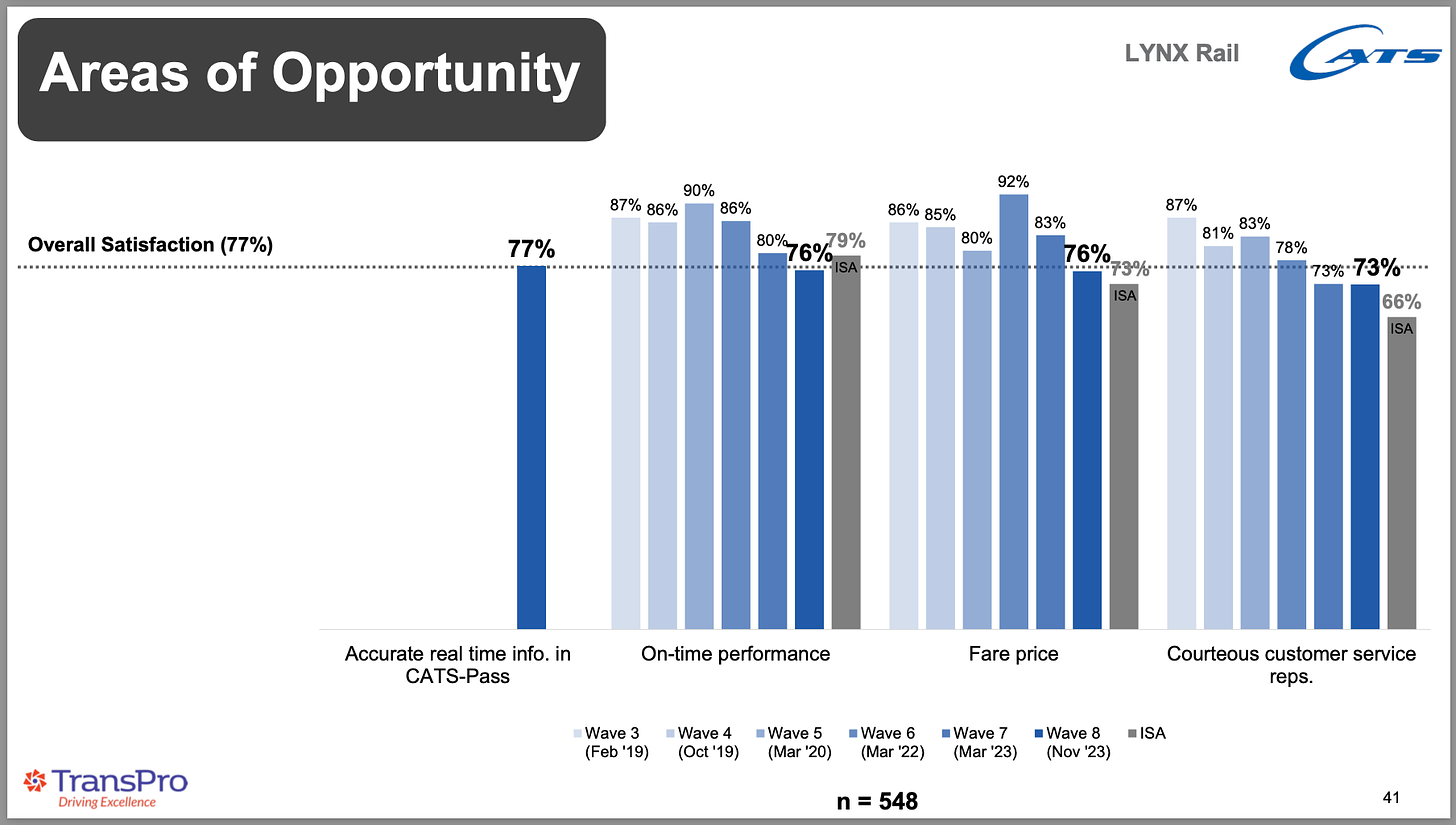

Charlotte voters have approved this bond issue without fully considering the consequences. Allocating funds to an already inefficient and bloated bureaucracy is unwise. The landscape of Charlotte has been forever altered, and not long ago, the Ledger highlighted a significant vacancy rate in downtown buildings. The most pressing need for public transportation in Charlotte is a connection from downtown and the blue line to the airport, which this bond issue fails to address.